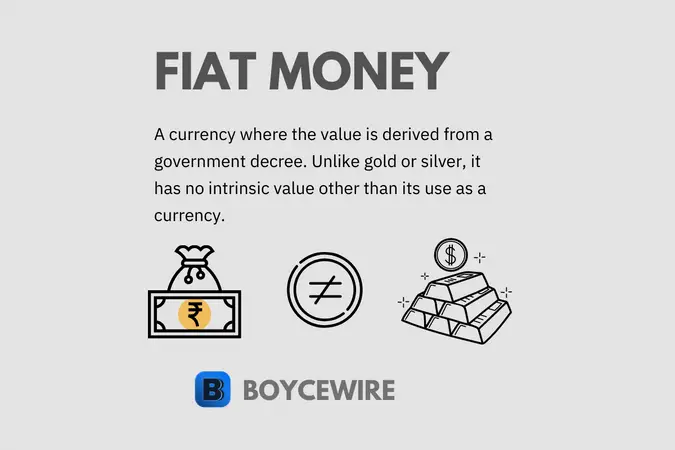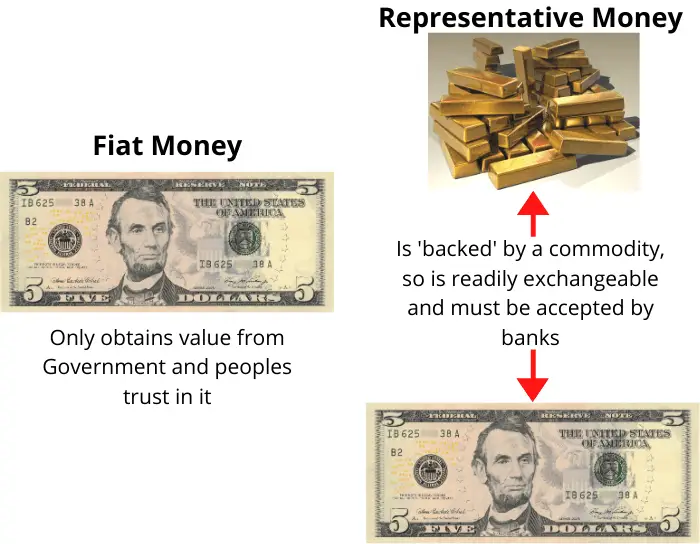Fiat Money: How it works, Examples, Pros & Cons

What is Fiat Money?
Fiat money is a currency that is deemed valuable by the government’s decree. It is recognized as a legitimate payment method and legal tender by the government, which means it can be used to settle debts and pay for goods and services. The term “fiat” comes from the Latin word meaning “decree” or “formal authorization,” which refers to the legal authority given by the government to use it as a medium of exchange.
The value of fiat money is derived from the trust placed in it by the public. If people do not have faith in its worth, businesses may refuse to accept it as a payment method, which can lead to a decline in its value. Thus, the true value of fiat money lies in the confidence of those who use it.
For instance, the US dollar is a fiat currency, and it holds its value because people have trust in the US government and its financial system. The government’s power to regulate its supply and demand also plays a significant role in maintaining its value. This distinguishes it from commodity money, which has intrinsic value based on its material composition, such as gold or silver.
Key Points
- Fiat money is a type of currency which derives its value through government decree.
- Once the public loses trust in fiat money, it can significantly impact the economy. For instance the overproduction of fiat money in the German Weimar Republic led to hyper-inflation.
- Central banks generally control the supply of fiat money, but this was historically under the power of domestic governments.
- Fiat money differs from commodity money in the fact that it is not backed by a physical good such as gold or silver.
How Fiat Money works
Fiat money is created through central banks. Historically, it was printed, but today, it is created digitally. Through open market operations, it typically generates new money and uses this to purchase government debt – typically from commercial banks. This then gets filtered through into the wider economy.
So how does it differ from commodity money? Well first of all, it doesn’t have any underlying value. Whilst a commodity like gold or silver has value outside its use as a currency – fiat money does not. Yet commodity money is naturally restricted. There is only so much gold or silver in the world. However, fiat money is almost unlimited – restricted only by the central banks willingness to create more.
Fiat Money is typically created by the Central Banks, with its supply only limited by the institutions willingness to create more.
Although government grants the value of fiat money, it would be worthless without the consumers trust. For instance, a number of African governments such as Zimbabwe have been known to print an excessive amount of money, thereby creating hyperinflation. New money floods the economy, thereby deflating its true value. This erodes people’s trust in the government’s ability to maintain its value.
This can encourage excessive levels of consumption as consumers don’t want to keep hold of cash for long in case it loses value. What this does is harm economic growth as it shifts capital away from savings and investment and towards immediate consumption. Instead, consumers would rather spend the money and have something to show for it rather than let inflation destroy their savings.
Examples of Fiat Money
In todays day and age, almost every country adopts fiat money as its currency. The only exception is Lebanon, which operates a form of the gold standard. Yet every other nation has adopted fiat money as its currency. Some examples include:
Euro
The European Central Bank (ECB) controls the Euro and is the official currency of 19 countries within the European Union. The Euro is fiat money because it is not exchangeable for anything other than the value of goods. In other words, it has no value other than its use as a medium of exchange.
US Dollar
The Federal Reserve controls the supply of the US dollar and is the official currency of all 50 US states. Whilst the US dollar has been around for centuries, it only recently became fiat money. Up until 1971, holders of the US dollar could readily exchange it for gold. It was only in August 1971 that President Nixon subsequently cut its ties with gold, in what was to become known as the ‘Nixon Shock’.
In the years after the Nixon shock, the US adopted a floating exchange rate and became the first country to adopt a true fiat money. In turn, the monetary system of the world changed. It brought about the natural evolution of money, with other nations following suit.
Great British Pound
The Central Bank of England controls the supply of the Great British Pound (GBP) and is the currency of all four nations in the British Isles: England, Wales, Scotland, and Northern Ireland. The UK abandoned the gold standard in 1931, yet was not a fiat currency. This was because it still had ties to gold.
Although the UK cut its ties to gold, it was still intrinsically linked to it through the Bretton Woods agreement of 1944. Rather than being backed by gold directly, it was pegged to the US dollar, which in turn, was backed by gold. The reason being was that the US had the largest gold reserves in the world and was on its way to becoming a global superpower. So the control of gold was essentially centralised in the US.
At the same time, the exchange rates between the US dollar and the Great British Pound were fixed. So it was still backed by gold in all but name. Holders of the Great British Pound would have to exchange the currency for a US Dollar and then again to gold. Yet this came to an end due to the ‘Nixon Shock’ which ended the US and consequently the UK’s indirect tie to gold.
Characteristics of Fiat Money
1. No Intrinsic Value
Fiat money has no intrinsic value, which means that by itself, it’s worthless. By contrast, commodity money has an underlying value which comes from the commodity itself. For instance, gold has other uses other than money and therefore, has an intrinsic value. However, fiat money has only one use and one use only – to act as a currency.
2. Value linked to Trust
Commodity money has an underlying value, so the average consumer knows that even if Mr A doesn’t accept it, then Mr B will. For instance, gold has historically held significant value due to its rarity – which is seen as a status symbol of power and wealth. By contrast, however, fiat money derives its value through people’s trust in its value and willingness to accept it.
If consumers did not have confidence in the fact that other people would accept it, the currency would have no value. If the average consumer knew Walmart would accept the currency, there would be a level of trust placed in it. However, fiat money falls apart when people start to refuse it as a medium of exchange. As it is legal tender, it means businesses such as Walmart have to accept it and therefore, enshrines peoples trust in it.
3. Backed by Government
Fiat money is only a fiat type of money if it is backed by government. Without government approval, it is not ‘fiat’ – which is defined as formal authorisation. In other words, it is ‘legal tender’. This could also be applied to other forms of money that government chooses to use. However, with fiat money, it is a defining trait as this is the main source of its value.
Businesses are legally required to accept fiat money, which helps establish consumers trust in its value. This is because consumers can trust the fact that they can go to their nearest store and exchange it for goods and services. If businesses don’t accept it, they can be subject to legal action.
4. Unlimited Supply
Technically, the supply of fiat money is endless. Central banks can ‘print’ an almost infinite amount – perhaps only being restricted by the amount of paper it requires. For instance, we only need to look at Venezuela as an example. Its currency, the Bolivar Fuerte, replaced the original Bolivar, but inflation still increased by thousands. This is because there are no clear restrictions on how much the government can or cannot print.
Advantages and Disadvantages of Fiat Money
As the world is operating under a fiat currency, there must be some logical explanation of why we trade it, which is essentially pieces of paper? Some advantages of fiat money include:
Pros
- There is no constraint on supply.
- Low cost to produce.
- Historically very stable when compared to other commodity currencies.
Cons
- Too much production can create inflation.
- Has little value outside its use as a currency.
- Can create asset price bubbles.
Advantages
1. Supply is Unlimited
Central Banks can produce as much money as they like and with the advancement of technology, they don’t even have to print it anymore. This is both an advantage, and, if not controlled properly, a disadvantage. However, let’s focus on it as an advantage.
The Central bank can produce Fiat money in any quantity. By contrast, gold, silver, or any other commodity is firstly limited by the number of laborers available to mine. And secondly, the limited nature of its existence.
If we look at what money essentially is; it represents the value of goods in the economy. So when money is traded, it represents the labor that went into it, as well as the value the consumer places in it. In turn, the amount of money in circulation has to increase alongside GDP and the number of goods and services in the economy.
If we look back to the Great Depression in 1929, the cause was linked to the decreasing supply of the US dollar when compared to the United States’ economic growth. At the time, the US dollar was linked to gold, which partly explains why the Federal Reserve was reluctant to print more dollars. It was representative money, so if it printed too much, there wouldn’t be enough gold to satisfy demand, particularly if there was a run on the banks.
This reluctance to print more money meant the money in circulation represented more and more goods each year. For instance, in a basic example economy, there is $1 million in circulation and 1,000 cars are made which represent this. That works out at $1,000 per car. However, in five years’ time, there is still $1 million in circulation, but 2,000 cars are now made. As a result, prices adapt to represent the amount of money in circulation. So the price of cars declines to $500.
This has its own effect on the wider economy, but the restrictive nature of commodity or even representative money can mean its supply is unable to match economic output. As a result, this provides fiat money with an advantage.
2. Cheaper to Produce
Commodity money and representative money both require the extraction of a commodity. Whether it is gold, silver, or something else, it requires labor to extract it. This alone provides a huge and arguably unnecessary cost.
So you need someone to mine it, transport it, mould it where necessary, and then finally store it. All in all, it adds an extortionate cost to maintain its supply. By contrast, the cost of fiat money is almost nil. Whilst there is the cost of production for the paper, much of the transactions are being done online. So the need for that is also declining.
3. Stability
Fiat money brings stability, partially because of the previously mentioned advantages. As the money supply can react to increasing economic output, it is able to represent the goods available much more effectively. It is cheaper and easier to produce, so it can enter the market in a short period of time.
In addition, there are other factors to consider. For example, in times of crisis, people tend to hoard commodities such as gold or silver. Similarly, currencies that are back by such are more likely to face a run on the banks. The Depression of 1929 is a classic example.
What fiat money does is cut ties with commodity money and therefore reduce demand for such commodities. This creates a greater level of price stability as consumers are not so prone to store it.
For instance, the 2008 Financial Crisis was the worst economic recession since 1929. Yet, at the same time, prices remained relatively stable. In the US, inflation never reached more than 4 percent, nor did it fall below -1 percent. Quite extraordinary considering the scale of the economic crisis.
If we look back at 1929, when the US was on the gold standard, inflation declined by a cumulative total of over 28 percent in the three subsequent years. However, it must be said that the stability is largely reliant on the decisions made by the Central Banks, which can have more of an effect than the type of currency used.
Disadvantages
1. Potential to Cause Inflation
With fiat money, Central Banks have the ability to create new money whenever. The issue with this is that sometimes the aim is not to control inflation, but to reduce unemployment and boost the economy. Unfortunately, Central Banks often over shoot and end up contributing to inflation. This is because it ends up printing money at a faster rate than the goods the economy is creating.
2. No Intrinsic Value
Fiat money is essentially paper notes. If shops did not accept a $20 bill, then it’s worthless. So when the trust in government fades, so too does the trust in the ability for the currency to maintain its value. This can come around due to governments mismanagement of its finances whereby lenders start to question its ability to pay. This can therefore reduce the value of the currency, making owners worse off.
3. Asset Price Bubbles
When Central Banks print money, it doesn’t always lead to inflation on everyday goods like butter and milk. Instead, the money often filters through to asset prices. This has been seen through the tech market booms, the house market booms, and the banking sector crash of 2009. When more fiat money is created than valued goods in the economy, it represents an excess of cash which eventually finds itself creating a bubble.
Fiat Money vs Representative Money
It is very easy to confuse fiat money and representative money. Both can be paper money such as the US dollar, and both have no value in and of itself. However, there is a key difference between the two.

Consumers that own representative money can exchange it for a commodity such as gold or silver. This is exactly what the US dollar did before the Bretton Woods agreement agreement ended in 1971. People were able to trade $35 for one ounce of gold. This meant that although the average US consumer exchanged pieces of paper (the US dollar), they could at any time redeem it for gold at the bank.
So representative money is similar to fiat money in that it is generally made of paper, but it represents a quantity of a commodity. This is in contrast to fiat money, which represents the value that people believe it is worth. In other words, how many goods or services does the consumer think $10 can buy.
FAQs
Fiat money is prevalent globally and includes currencies such as the US dollar, which is declared legal tender by the government without being backed by a commodity.
The word ‘fiat’ comes from the latin meaning ‘formal authorization’. So ‘fiat money‘ is a type of money which is legally authorized for use by the government. This means that businesses must legally accept it as tender.
One of the main advantages of fiat money is that the supply can be increased at any point to meet the demand of the economy.
Second of all, fiat money costs but a fraction to maintain when compared to other forms of money that rely on a commodity.
Third of all, it is relatively stable. At least under a compontent Central Banking system.
Fiat money obtains value through government which decrees it as legal tender. In other words, businesses must accept it as a medium of exchange. In turn, consumers have confidence in its value as they know they can buy goods and services with it.
About Paul
Paul Boyce is an economics editor with over 10 years experience in the industry. Currently working as a consultant within the financial services sector, Paul is the CEO and chief editor of BoyceWire. He has written publications for FEE, the Mises Institute, and many others.

Further Reading
 Cartel - A cartel in economics is an organization or group of firms that collude to restrict competition and control market prices…
Cartel - A cartel in economics is an organization or group of firms that collude to restrict competition and control market prices…  Offshoring: Definition, Pros, Cons & Examples - Offshoring is where a business moves its operations abroad.
Offshoring: Definition, Pros, Cons & Examples - Offshoring is where a business moves its operations abroad.  Stagnation: Definition, Causes & Examples - In economics, stagnation is where a nation experiences an extended period of low economic growth.
Stagnation: Definition, Causes & Examples - In economics, stagnation is where a nation experiences an extended period of low economic growth. 